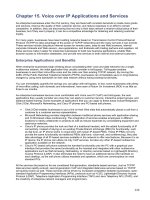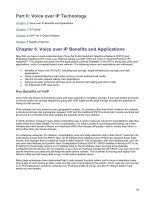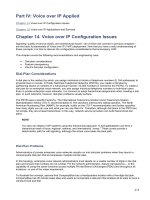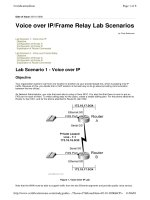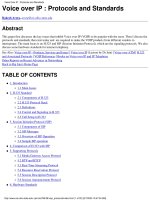Voice over IP Benefits and Applications
Bạn đang xem bản rút gọn của tài liệu. Xem và tải ngay bản đầy đủ của tài liệu tại đây (506.93 KB, 15 trang )
Part II: Voice over IP Technology
Chapter 6 Voice over IP Benefits and Applications
Chapter 7
IP Tutorial
Chapter 8
VoIP: An In-Depth Analysis
Chapter 9
Quality of Service
Chapter 6. Voice over IP Benefits and Applications
Now that you have a good understanding of how the Public Switched Telephone Network (PSTN) and
Enterprise Telephony (ET) work, you might be asking yourself, "Why put voice on Internet Protocol (IP)
networks?" This chapter discusses how the applications currently available in the PSTN, along with other new
applications, work in a packet-based voice network. The following issues and applications are addressed:
• Benefits of Voice over IP (VoIP), including cost savings, single infrastructure savings, and new
applications
• Using a packet telephony call center versus a circuit-switched call center
• Service provider prepaid calling card applications
• Service provider enhanced services (such as Internet call waiting and click to talk)
• An enterprise VoIP case study
Key Benefits of VoIP
One of the key drivers of combining voice and data networks is monetary savings. If you look strictly at minute-
to-minute costs, the savings realized by going with VoIP might not be large enough to justify the expense of
rolling out this service.
Price savings can vary based on your geographic location. In countries other than North America, for instance,
a minute-to-minute cost comparison between VoIP and the traditional PSTN (a local call in some countries can
be around $1 a minute) more than justifies the expense of the new network.
In North America, however, many large corporations pay 3 cents or less per minute for long-distance calls they
make within the United States. For such corporations, it is hard to justify to accounting that rolling out a new
infrastructure will provide a Return on Investment (ROI) that will pay off quickly—that is, unless they factor in
items other than per-minute charges.
For enterprise networks, for instance, consolidating voice and data networks might mean the ET customer can
order fewer circuits from the PSTN. Also, an IP infrastructure (utilizing Cisco IP phones) requires fewer adds,
moves, and changes than a traditional voice or data network. This is because, with one infrastructure, you can
use such data features as Dynamic Host Configuration Protocol (DHCP). DHCP enables a device (a PC or an
IP phone) to dynamically receive an IP address (that is, the IP address does not need to be statically
configured into the device). So, for instance, if you have an IP phone configured with DHCP, you can move the
phone wherever you need and still keep the same phone number. This is similar to moving your laptop from
office to office and still being able to log in to the same network server.
Many large enterprises have determined that it costs several hundred dollars just to move a telephone today
(this is due to such factors as labor costs and the cost of reconfiguring the switch). Such costs are not incurred
in an IP infrastructure, however, because your IP phone profile is set up, and the IP network doesn't care
where you are located.
95
NOTE
The Cisco Communication Network is part of Cisco's Enterprise VoIP network. It consists of an IP
phone and a Cisco Call Manager. In the Cisco Call Manager, profiles are set up for each individual
phone based upon the static Media Access Control (MAC) address of the IP phone. The IP phone
simply has to send out a DHCP request when it's plugged into an IP network. The DHCP response
includes the IP address that the IP phone is to use, as well as potential Cisco Call Managers to log
in to. The IP phone then contacts the Cisco Call Manager and downloads its profile (phone number,
features, and so on).
An additional benefit of VoIP is the ability to have one Information Services (IS) department that supports both
voice and data networks (as the networks are now one entity). This can initially cause tension between these
two infrastructures, but as with any technological revolution, one must enhance one's skills to survive. This has
been the case with the introduction of most new technologies—from the cotton gin to robots.
One benefit of VoIP that enterprises and service providers often overlook is the fact that common infrastructure
tools are now no longer needed. These include such tools as physical ports for services such as voice mail. In
a circuit-switched voice network, voice mail is sold based on the number of mailboxes and the number of
physical ports needed to support simultaneous users. With VoIP, physical circuit-switched ports are not
necessary. The voice mail server need only have an IP connection (Ethernet, Asynchronous Transfer Mode
[ATM], and so on).
Also, VoIP enables voice mail systems to be put on standards-based platforms (such as PCs and UNIX
machines). After a feature is on a standards-based platform, price gouging is much less likely to occur. Voice
mail providers today, for example, charge 50 cents to $1.50 per megabyte for hard-drive space because they
use a proprietary mechanism to format and store their voice calls. On the other hand, the average price for
hard drives at the local PC store is approximately only 3 to 4 cents per megabyte.
What if your voice mail server was the same as your e-mail server and you could decide whether to download
your voice mail over a telephone or use your e-mail client to peruse your voice mail? Those who travel will truly
appreciate benefits such as the capability to download voice mail and respond electronically, and to forward
voice mail to a group. Such technology exists today and will soon be available and widely used through
enterprise and service provider networks.
Packet Telephony Call Centers
In most call centers today, the largest costs are for the brick and mortar holding the building together. You can
drastically cut the actual costs of renting a building, putting a phone at each desk, and purchasing the required
infrastructure (call-routing technology, PCs, and so on) by using a Packet Telephony Call Center (PTCC).
Each call center is different, but for many call centers, the ability to grow the business as needed (perhaps as
discretely as one station at a time) is a great benefit. Currently, call centers must grow in chunks. The size of
these chunks depends on how many ports the call centers can purchase for their Private Branch eXchange
(PBX) at a time. This is a great disadvantage because call centers usually need to be flexible and be able to
grow and shrink as the number of required stations changes.
Many call centers are unable to grow in smaller chunks because the hardware necessary to provide desktop
phone services is sold only in larger units (such as growing one to several T1s or E1s at a time, instead of a
phone at a time). This prevents the call centers from being able to grow quickly based on seasonal or natural
growth.
Circuit-Switching Call Centers (CSCCs) enable users to work from home and still take calls, but this equipment
is expensive. With PTCCs, users can log in to a phone no matter where they are and have access to the exact
same features as if they were at their desk, and the costs are much lower.
A CSCC currently uses a device known as a PBX Extender, a remote piece of equipment that extends the
features of the PBX to the user's premises. A PBX Extender can run upward of $1000 per user, and that's just
96
for the equipment itself. You also have to purchase software that must be added to the central site; the circuit
to the worker's residence; and Customer Premise Equipment (CPE) gear, such as the router, for the remote
site.
When you use a VoIP network, however, you don't need additional equipment for the remote site. You can
take the same phone you use at work and have exactly the same functionality. Of course, the company still
has to purchase the circuit to the worker's residence, as well as the CPE equipment.
Nevertheless, VoIP lowers the costs of locating stations anywhere geographically. In doing so, VoIP gives call-
center operators a great advantage in terms of hiring skilled or unskilled workers, as well as growing and
shrinking the number of stations needed at any given point in time.
In a packet telephony infrastructure, you can have a group of distributed virtual agents that you can locate
anywhere, and you can still offer them the same tools that a traditional call center offers. Figure 6-1
shows
ways you can use a common IP infrastructure to unite various methods, and it showcases one possibility of
telecommuters as virtual agents.
Figure 6-1. Virtual Agents
Two of the challenges facing CSCCs today are cost and employee retention. Descriptions of these challenges
are as follows:
• Many toll-free numbers—CSCCs must manage the number of circuits the enterprise uses. Using more
circuits increases the cost of operating the CSCC and, therefore, can potentially decrease profits.
• Misrouted/rerouted calls—Each time a call must be routed to a different agent (because, for example,
an agent might not have the correct skills to answer a customer's question, or he does not speak a
customer's language), revenue is lost.
• Multiple centers—The capability to "follow the sun" increases the "brick-and-mortar" costs in a CSCC.
Following the sun implies that different physical call centers must exist to keep workers working a
normal shift. This also is known as time-of-day routing. (When the United States call-center operators
are sleeping, for example, Australian operators can take the calls.)
• Percentage distribution/overflow routing—The capability to handle overflow between different physical
locations increases the profitability in a peak call-flow time. But, if this overflow mechanism is not
properly managed, it can cost more to overflow the call than to not service the incoming call.
• Employee turnover—Call-center work can be stressful, and, because of the repetitive nature of such
work, keeping workers can be difficult.
• Seasonal staffing needs—Oftentimes, call centers experience more volume during certain periods. As
such, they must hire people to accommodate the high-volume periods, and then lay people off when
volume drops. (This is a common plight of technical support staff during the holiday season, for
instance.)
97
• Inconvenient busy hours—If the call center does not have a "follow the sun" model, it must hire staff to
work inconvenient hours, such as the night shift, for instance.
• Regional call-center talent—Having skilled workers come into a brick-and-mortar facility can lower the
number of possible workers in the pool of talent. Telecommuting so that regional workers can work
within any geography in a specific time zone increases the number of workers in the available pool.
The CSCCs are adapting to meet these challenges, as well as meet new demands. One of the solutions to the
previously mentioned challenges is increased efficiency. To become more efficient, practice the following
principles:
• Computer Telephony Integration (CTI)—One application is for caller information (such as the caller's
name, buying patterns, and address) to be "popped" onto the agent's screen so that the agent can
handle the call more quickly.
• Skills/application-based routing—Routing calls to the proper agent based on technical skills, language,
and any other skill can increase the speed by which the call is handled.
• Information duplication—Call agents can avoid asking the same question twice if transferred to a new
agent. This is possible due to the information on the first agent's screen "popping" onto the new
agent's screen when the call is transferred to the new agent.
• Interactive Voice Response (IVR)—This enables callers to input basic information (such as account
information) so that calls can be handled more quickly.
CSCCs will upgrade to an integrated voice and data network initially based on cost. But, the true value (which
might be hidden to some) is in the value-added services and applications that can be offered after this
enhanced network is in place.
Some of these services and applications include having both your voice mail and e-mail integrated into one
application; using Web-based customer support; having CTI capability; being able to fax in and out from the
desktop (and fax to your e-mail account); and being able to conduct desktop video conferencing with your
customer.
Traditionally, an entire call center revolves around the PBX (as shown in Figure 6-2
). As such, call centers
are held ransom by the number of ports they can afford at any given point in time. Reliance on the PBX also
forces the CSCC to deploy applications only when they are compatible with the PBX or when the CTI link
enables the field to be passed.
98
Figure 6-2. Circuit-Switching Call Center
In a PTCC, the network is integrated and standards-based and does not rely on only one component or vendor
to provide the entire solution.
This enables the call center to have remote users for a fraction of the cost of PBX extenders (thanks to
integrated CPE gear). This also enables the business to grow in the increments that customers need, and
enables the business to add new applications (such as data/voice collaboration) as needed.
Another important issue with CSCCs is the ability to retain and develop current employees. Studies show that
giving employees options on schedules and "flex-hours" greatly increases the retention rates of many
companies.
Although Figure 6-2
shows how a CSCC is efficient for a large centralized call center, the CSCC design lacks
the flexibility to enable telecommuters, and it lacks a true integration into Internet telephony or unified
communications (such as fax–to–e-mail).
PTCC enables you to retain a connection into the legacy PBX call center, but it also enables integration into
the new network of Web support, Internet telephony, and unified communications. Figure 6-3
shows the
components and network design of a PTCC.
99
Figure 6-3. Packet Telephony Call Center
This connection to the legacy PBX is accomplished by having an external call-processing engine that connects
to the PBX and to the Cisco Call Manager through CTI links. The external call-processing engine enables
telecommuters and PBX call agents to answer calls as though they are attached to the call center.
Also, with a connection from the legacy CSCC into the IP network, you can use enhanced features such as IP-
based IVR systems (also known as Voice Response Units [VRUs]) and unified messaging services such as
fax–to–e-mail, text-to-speech, speech-to-text, and so on.
As you can see in Figure 6-3
, the Call Center Corporation is no longer tied to physical ports for the VRU, and
the entire messaging infrastructure (e-mail, voice mail, applications, and so on) is tied into one common
infrastructure.
The call-routing or call-processing engine is now just part of the data network and is removed from the PBX.
This enables telecommuters, call-center agents, and branch office agents to have the same access to the
same information. Access to a common infrastructure gives everyone equal footing, and it gives the customer
a common look and feel, as shown in Figure 6-4.
Figure 6-4. Common Infrastructure for All Call Agents
This new architecture also enables you to stop making unnecessary expenditures on legacy CSCC gear and
begin expanding into the packet telephony call-center space. This, in effect, frees you from having to grow
100

